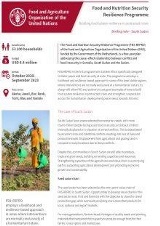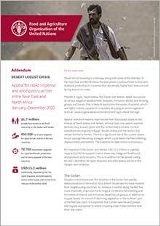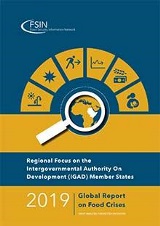Publications
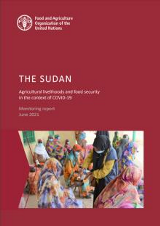
The Sudan: Agricultural livelihoods and food security in the context of COVID-19
07/2021
This report shares an analysis by the Food and Agriculture Organization of the United Nations (FAO) on the effects of coronavirus disease 2019 (COVID-19) on the agri-food system in the Sudan.

Greater Horn of Africa and Yemen: Desert locust crisis appeal, January 2020–December 2021
07/2021
The worst desert locust outbreak in decades is underway in the Greater Horn of Africa and Yemen, where tens of thousands of hectares of cropland and pasture have been damaged in Djibouti, Eritrea, Ethiopia, Kenya, Somalia, South Sudan, the Sudan, Uganda, the United Republic of Tanzania and Yemen, with potentially severe consequences for agriculture-based livelihoods in contexts where food security is already fragile.

Sudan: Humanitarian Response Plan 2021
03/2021
The Sudan continues to suffer from one of the world’s largest protracted humanitarian crises, with the situation deteriorating significantly in 2020 due to widespread floods, civil unrest and conflict.
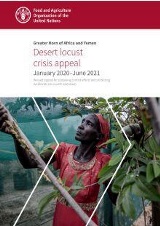
Greater Horn of Africa and Yemen: Desert locust crisis appeal January 2020 – June 2021
12/2020
The document is the revised version of the previously published Desert locust crisis appeal, providing an update and expansion of FAO's funding requirements for rapid response and sustained actions in the Greater Horn of Africa and Yemen to address the ongoing crisis.
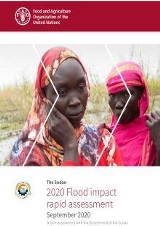
The Sudan: 2020 Flood impact rapid assessment
10/2020
Since July 2020, heavy rains and flooding combined with historical overflow of the River Nile and its tributaries have affected most of the states in Sudan, causing devastating damage alongside riverbanks in the northern, central and eastern regions of the country.
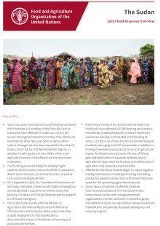
The Sudan: 2020 Flood Response Overview
10/2020
Since July 2020, torrential rains and flooding combined with the historical overflow of the River Nile and its tributaries, the highest levels in a century, have impacted 17 states out of 18 in the Sudan.
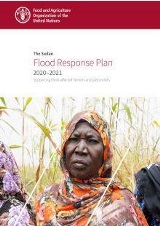
The Sudan: Flood Response Plan 2020–2021
10/2020
The Sudan is a country in transition that is facing multiple crises, ranging from political, economic, health and environmental issues. The latest Integrated Food Security Phase Classification (IPC) for June–September 2020 estimated that 9.6 million people in the Sudan are facing crisis or worse levels of food insecurity (IPC Phase 3 or above), of whom more than 2.2 million are in Emergency (IPC Phase 4).
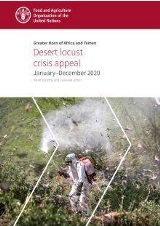
Greater Horn of Africa and Yemen: Desert locust crisis appeal (January–December 2020)
05/2020
The worst desert locust outbreak in decades is underway in the Greater Horn of Africa and Yemen, where tens of thousands of hectares of cropland and pasture have been damaged in Djibouti, Eritrea, Ethiopia, Kenya, Somalia, South Sudan, the Sudan, Uganda, the United Republic of Tanzania and Yemen, with potentially severe consequences for agriculture-based livelihoods in contexts where food security is already fragile.

FAO's role in humanitarian contexts: Saving lives through stronger, more resilient livelihoods - Revised version
04/2020
The number of people experiencing hunger – both chronic and acute – has been persistently high in recent years.
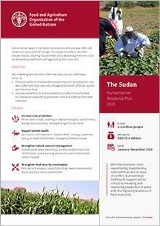
The Sudan: Humanitarian Response Plan 2020
02/2020
Humanitarian needs in the Sudan continue to climb one year after civil unrest and socio-political change. The impact of conflict, recurrent climatic shocks, resulting displacement and a worsening economic crisis are threatening livelihoods and aggravating food insecurity.

Resilience analysis of pastoral and agropastoral communities in South Sudan’s cross-border areas with Sudan, Ethiopia, Kenya and Uganda
09/2019
The IGAD member states are situated in a region exposed to recurrent natural shocks, political instability and characterized by internal and cross-border population displacement.
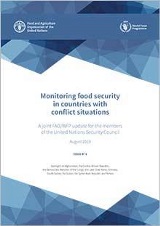
Monitoring food security in countries with conflict situations (Issue No.6 - August 2019)
09/2019
This update, facilitated by the Food Security Information Network and produced under the Global Network Against Food Crises, provides the members of the United Nations Security Council with an overview of the magnitude, severity and drivers of acute food insecurity in nine countries and territories that have the world’s highest burden of people in need of emergency food, nutrition and livelihood assistance as a result of protracted conflict combined with other factors.
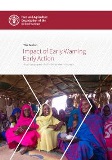
The Sudan: Impact of Early Warning Early Action
06/2019
Protecting agropastoralist livelihoods ahead of drought
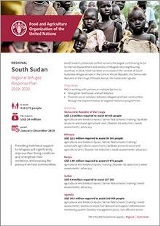
South Sudan Regional Refugee Response Plan 2019–2020
02/2019
South Sudan’s protracted conflict remains the largest contributing factor to internal displacement and exodus of refugees into neighboring countries.
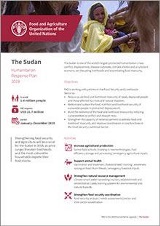
The Sudan: Humanitarian Response Plan 2019
02/2019
The Sudan is one of the world’s largest protracted humanitarian crises: conflict, displacement, disease outbreaks, climatic shocks and a turbulent economy are disrupting livelihoods and exacerbating food insecurity.

